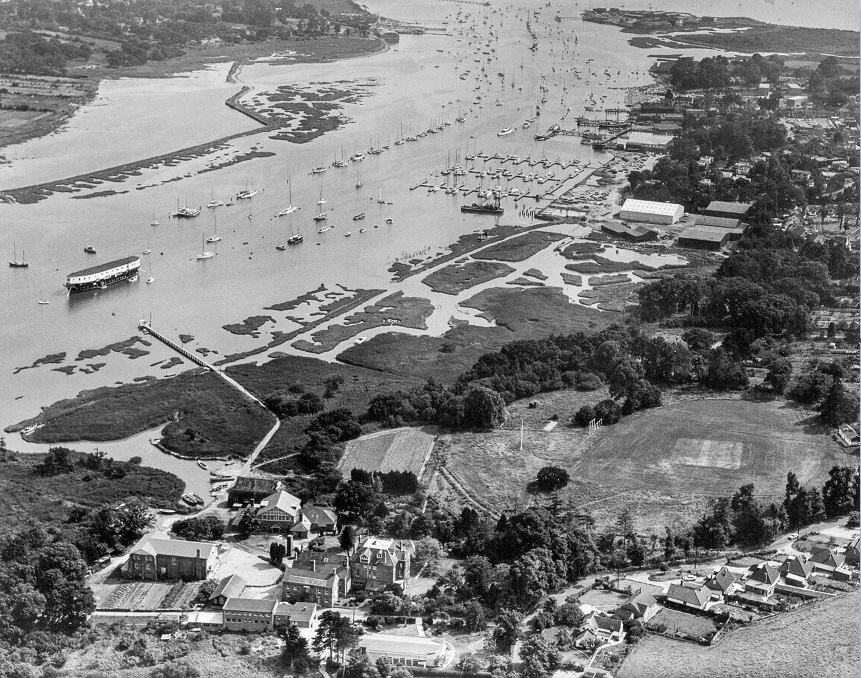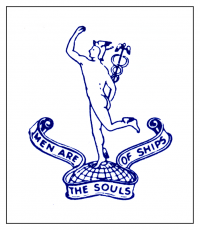
At the start of the 20th Century Britain needed at least 10,000 boys to receive pre-sea training to meet the requirements of the Royal and Merchant Navies. The Training Ship ‘Mercury’ was one of over thirty pre-sea training establishments founded during the Victorian period to meet this need. These ranged from fee-paying training ships for prospective officers in the Merchant Navy to reformatory ships for juvenile delinquents who mostly joined the navy as seamen or stokers. ‘Mercury’, however, was the only privately owned establishment training boys for both the Royal and Merchant Navies.
T.S. ‘Mercury’ was founded on the south coast of England in 1885 by Charles Hoare. Charles was born in 1847 into a wealthy London banking family and went on to become a senior partner in the business. In addition, as well as being a patron of the arts and a friend of the Prince of Wales, he was also an exceptionally keen sportsman. He played cricket at county level and was a well known Master of Foxhounds. Furthermore, he was a keen yachtsman and it is probably this latter interest together with his charitable interests that were major influences on him founding the ‘Mercury’. In those days boys could get sea training in one of two ways. Firstly, if a boy’s parents were wealthy they could pay the full fees to an appropriate training ship. Alternatively, if their circumstances were dire enough, a local authority may pay their fees or they may be sent to one of the reformatory ships. Charles Hoare’s intention was to address those that fell between these categories by providing free (or nearly free) schooling and nautical education to boys between the ages of 12 (when compulsory schooling ceased) and 15, which was the minimum age for enlistment in the Royal Navy.
The school was initially housed in the barque “Illovo” (which had been renamed ‘Mercury’) and was moored at Binstead on the Isle of Wight. It was aboard this ship that the school went on its one and only cruise. ‘Mercury’ set sail for the Mediterranean in 1888 and wintered in Villefranche on the Cote D’Azur returning safely in March 1889.
In 1892 ‘Mercury’ move to the River Hamble near Southampton. In conjunction with this move, land ashore had been acquired and the beginnings of the shore based element of the school started.
In 1908 Charles Hoare died and the ‘helm’ of ‘Mercury’ was taken over by his friend, the famous scholar and cricketer Charles Burgess Fry. Beatrice Holme Sumner had helped Charles Hoare found the school and had worked alongside him throughout those early years. CB had, in fact, been married to Beatrice since 1898. As a result, CB and Beatrice ran the school together from then on with Beatrice taking a prominent role until her death in 1946 (CB died in 1956).
The original ship was supplemented in 1914 with H.M.S. President which, at the time, was a Naval Reserve drill-ship moored in West India Docks, London. President had, in fact, been launched as the sloop, H.M.S. ‘Gannet’ in 1878 and was one of the generation of ‘Down Funnel, Up Screw’ ships. She had served with the Royal Navy and seen action in the Red Sea during the war in the Sudan. She had been loaned to the school by the Admiralty following an inspection of ‘Mercury’ by the then First Lord of the Admiralty, Sir Winston Churchill and was towed to the school by the battleship, H.M.S. “Queen”. Illova was finally sold in 1916.
Even though the ship really only acted as a dormitory for the school (the boys slept in hammocks), she became a central and key part of ‘Mercury’. She was, in fact, its heart. In the winter she was bitterly cold. For example, in spite of the later addition of so-called ‘central heating’ it was still not uncommon for boys to find ice on their hammocks when coming aboard at night. But conversely, on a warm summer’s morning there was nothing better than to wake up and see the river reflected in the roof above and to hear the sea gulls. It would be true to say that in the winter ‘Mercury’ had the appearance of a Gulag whilst in the summer it resembled a holiday camp.
Following the deaths of Beatrice and CB, the school continued under the guidance of Commanders Bradby and Hoyle. After training over 5000 boys, it was Commander Hoyle who had the misfortune to have to oversee the closure of the school in July 1968 due to the economic realities of the modern world. In fact, the era of the training ship was over as, within a few years, most of the other similar establishments also closed. Throughout its 83 years the school enjoyed the encouragement and interest of members of the royal family, eminent politicians and distinguished naval officers including Admiral of the Fleet Earl Mountbatten of Burma who was president of ‘Mercury’ for the last two decades of its existence.
The school was prominent in the lives of the local people. The boys in uniform were an everyday sight around Hamble and the local villages. In particular, the T.S. ‘Mercury’ band was a favourite for local carnivals and fetes. Also, they could hardly miss the so called ‘hulk’ on their lovely river. Certainly the corrugated iron topping given to President in its ‘drill ship’ days did little for the graceful lines of the former H.M.S Gannet or the River Hamble.
H.M.S. President was returned to its rightful owners and after many years of uncertainty eventually found a home at the Historic Dockyard, Chatham where she can be seen today (as H.M.S. Gannet) restored and open to the public. Her very existence today is due mainly to her association with ‘Mercury’ and the way she was kept in a state of hibernation on the River Hamble from 1914 until 1968. However we should not forget those dedicated individuals who kept up the good work in those years of uncertainty following the school’s closure when the ship languished in Portsmouth Harbour looking for a benefactor.
